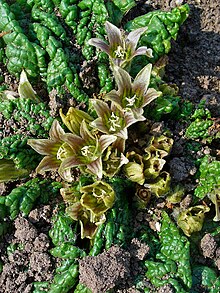
Back يبروح Arabic يبروح ARZ Mandraqora Azerbaijani Мандрагора Byelorussian Мандрагора BE-X-OLD Мандрагора Bulgarian Mandràgora Catalan Mandragora CEB Mandragora Czech Alrune Danish
| Mandragora | |
|---|---|

| |
| Mandragora officinarum | |
| Scientific classification | |
| Kingdom: | Plantae |
| Clade: | Tracheophytes |
| Clade: | Angiosperms |
| Clade: | Eudicots |
| Clade: | Asterids |
| Order: | Solanales |
| Family: | Solanaceae |
| Subfamily: | Solanoideae |
| Tribe: | Mandragoreae |
| Genus: | Mandragora L. |
| Species | |
Mandragora is a plant genus belonging to the nightshade family (Solanaceae). Members of the genus are known as mandrakes. Between three and five species are placed in the genus. The one or two species found around the Mediterranean constitute the mandrake of ancient writers such as Dioscorides. Two or three further species are found eastwards into China. All are perennial herbaceous plants, with large tap roots and leaves in the form of a rosette. Individual flowers are bell-shaped, whitish through to violet, and followed by yellow or orange berries.
Like many members of the Solanaceae, species of Mandragora contain highly biologically active alkaloids that make the plants poisonous.[1] Their roots in particular have a long use in traditional medicine.[2] Mandrakes are involved in many myths and superstitions.[2]
- ^ Fatur, Karsten; Kreft, Samo (April 2020). "Common anticholinergic solanaceaous plants of temperate Europe - A review of intoxications from the literature (1966–2018)". Toxicon. 177: 52–88. doi:10.1016/j.toxicon.2020.02.005. PMID 32217234. S2CID 213559151.
- ^ a b Fatur, Karsten (June 2020). ""Hexing Herbs" in Ethnobotanical Perspective: A Historical Review of the Uses of Anticholinergic Solanaceae Plants in Europe". Economic Botany. 74 (2): 140–158. doi:10.1007/s12231-020-09498-w. ISSN 0013-0001. S2CID 220844064.
© MMXXIII Rich X Search. We shall prevail. All rights reserved. Rich X Search